
Crop: Orchids
Scientific name :
Common / Local Name :

Orchids are considered to be the world’s most beautiful of God’s creation are valued for their exquisite flowers and long keeping quality. They belong to the family Orchidaceae and are perennial herbs. Nearly 24000 species of orchids spreads over 140 genera are reported from India, besides Hybrids produced regularly.
Orchids, which grow on trees, are known as epiphytes. Those that grow on the ground are referred to as tressestrial. Those that grow on rocks are known as lithophytes, while some relatively little known ones grow on decaying matter or rotting logs are known as saprophytes. A few orchids grow as semi aquatic condition, submerged in water and sometimes only the inflorescence reaching the surface.
Orchids exhibit two types of growth habits based on their style of vegetative growth as follows.
Monopodial: have single non-branching stem, which grows upwards their stem lengthen from one season to another, e.g. Vanda and Arachais.

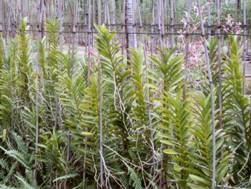
Monopodial orchids
Sympodial: have a rhizome, which grows horizontally producing new growth. A well developed sympodials plant contains a clump of shoots of different sizes and age the growth of each axis ceases at the end of each flowering e.g. Dendroburm, Cattleya, Oncidium, Cymbidium. A single plant will thus produce a series of annual axis in course of time.
sympodial orchids
 Sympodial orchids
Sympodial orchids
 Sonia-17
Sonia-17
 Singapore White
Singapore White
Sometimes an orchid plant grows simultaneously in the apical direction season after season as well as in the horizontal direction. These are known as pseudomonopodials.
Orchids are grown by seeds, tissue culture and vegetative propagation. For commercial cultivation it is best to use tissue culture plants from a recognized/reputed nursery. Vegetative propagation is much easier for a small-scale garden.
- Stem cuttings of 40 �?50 cms long with at least two well developed aerial roots are ideal. If smaller cuttings are planted, the time taken for flowering will be longer.
- Layering is successful in monopodials like Vanda stem at about 20 �?30 cm below the apex. The wound may be covered with some moist media. The layer can be separated when they strike roots.

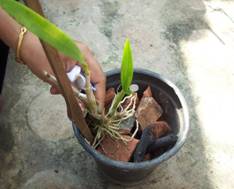
Division: It involves division of large clumps into smaller units. Each unit should have at least 4 �?5 shoots including old ones. This method is suitable for Dendrobiums, cattleya etc.
Off shoots or kiekies: Some orchids like Dendrobiums produce small plants with roots at the nodes of pseudobulbs. These are called ‘keikis' meaning ‘babies�? These when sufficiently grown are to be separated carefully from the mother plant and potted independently or they may be attached to coconut husk shells and allowed to gain reasonable growth.
Back bulbs: The older shoots or canes of sympodial Orchids, which are lesser active physiologically, are called back bulbs. These may be severed off the mother plants and kept horizontally over a moist medium. After sometime they will strike roots and sprout. Then they can be separated and planted.
Cultural Practices: Most of the cultivated orchids are air plants and as such require plenty free movement of air. It helps to maintain temperatures and humidity at desired levels. If grown in a green house/shade house the position may be adjusted for proper air circulation. Varieties like Vanda, Aerides, cattleyas do well in hanging baskets rather than pots or benches as they receive more air current.
Light: Is an important factor for proper growth pf orchids. In general they love diffused sunlight. It is possible to keep them in full sunlight, however the leaves turn scorched. The right amount of light helps in proper growth and nutrient storage, which will ultimately help in the blooming cycle. When the leaves are dark green to light it is an ideal condition. If the leaves become yellow the plant needs to be moved to a shadier location. So also sudden brown splotches or orange patches at the apex of leaves or at folds means the heat is unbearable. Sometimes the plants darken their foliage with plum coloured pigments. This is known as Suntan. It may take the form of spot ling or the whole leaf may darken. In this way the plant protects itself from burning.
Growing : 5000-8000lux
Flowering : 8000-15000lux
Orchids are classified into three groups depending on their heat requirements cool in temperate zones, intermediate in subtropical and hot or warm for tropical. For our conditions day temperatures between 56o F to 80o F are usually best.
Humidity: Orchids prefer humidity in the range of60% to 80%. Over watering orchids is not advisable. Watering interval also depends on the media used for planting. If moss or bark is used the interval of watering is longer as it retains a lot of moisture. Plants grown in baskets require more frequent watering as compared to those grown in pots. In cloudy weather and during Monsoon the watering interval should be less frequent as compared to summer months.
The first watering in the morning should be through i.e. the plants and media should be soaking wet and aid to leach out salts and wash off dust etc subsequently watering can be lighter with the last watering before sun down so the leaves are dry during the night.
When humidity is low the floor walls etc can be sprayed with water to improve the condition.
For teresstrial Orchids one part rich humus with decayed leaf mould half a part of decomposed and dried compost, one part of sphagnum moss or coir pit mixture is to be prepared as a perfect drainage should be ensured. This mixture is put into beds or earthern pots. Sufficient drainage material should be provided at the bottom. This should be in a sunny location and plants need to be staked.
For epiphytic orchids a large number of growing media are in use as follows.
Coconut husk: This absorbs sufficient quantity of moisture and is easily available and cheap. The proportion of husk has to be adjusted so it does not make the media soggy.
Tiles, bricks etc: They absorb moisture and are very useful for drainage.
Charcoal: Charcoal is useful for purifying the media besides being handy and safe while planting an orchid large pieces of potting material are placed near the drainage hole and then the potting mixture along with the plant which should be staked. When growing in beds, similar care should be ensured. Special clay pots with holes are available for planting Orchids. Plastic containers are also ideal as they are light in weight and do not allow algae to accumulate on their sides. Wooden baskets are specially used for Vandas as they have limited vertical growth. Raised platforms are constructed for placing pots in case of commercial cultivation.
When planting sympodials care should be taken when planting to ensure the oldest shoot touches the side of the container and the growing point faces the center of the container.
Replanting or Repotting is necessary. When the plant becomes crowded and when the media has broken down.
Nutrient Management: Nutrients, their quantity and frequency of application depends largely on the type of orchid, potting medium, season of the year, growing conditions, stage of growth etc.
A fertilizer mixture containing 1:1:1 is required during early growth at fortnightly intervals. Mature plants need to be fed with 3:1:1 ratio mixture during pre flowering stage and 1:2:2 during flowering stage. Organic manure like slightly fermented solution of cattle manure (1:25), oil cakes (1:10), cow’s urine (1:25), tender coconut water (1:20) are also very useful which can be applied 2 to 3 times a week under tropical condition.
A fertilizer mixture containing major nutrients and minor nutrients is ideal for Foliar application as most of the cultivated varieties are epiphytes and the media used is highly porous. A fertilizer dose containing 1:1:1 proportion of NPK is beneficial during early growth, 3:1:1 mixture may be used for mature plants as pre flowering and 1:2:2 during flowering stage at fortnightly intervals. Besides Organic manures like slightly fermented solution of oil cakes (1:10), cattle manure (1:25), cow’s urine (1:25 dilution) are also very suitable besides bone meal which can be sprayed ay intervals of 2 to 3 times a week under tropical condition.
Orchids basically being tough plants are resistant to diseases and pests and are capable of enduring a considerable amount of environmental stress. The main cause of stress is related to water. Too much water caused by over watering or a poor drainage medium makes them rot. Too little water in the roots or in the air, invites scales, mealy bugs and other insects. If the leave are not washed occasionally population of spider mites explode in their dusty surfaces. Leaves and flowers cannot tolerate long periods of wetness, which encourages infection by Fungi and bacteria. The problems can be avoided by keeping the plants and growing area clean. Cut the dead material of the plants as soon as you notice. Remove dead leaf tips with clean and sharp scissors.
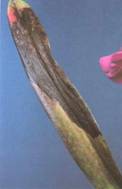 Black rot in orchids
Black rot in orchids
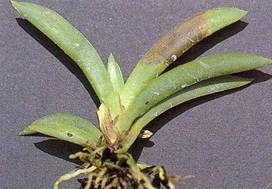 Black rot in orchids
Black rot in orchids
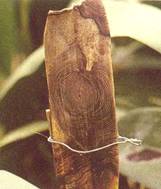 Anthracnose in orchid
Anthracnose in orchid
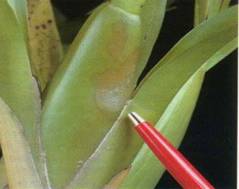 Soft rot in orchids
Soft rot in orchids
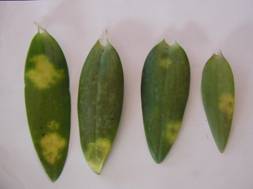 TMV in orchids
TMV in orchids
As orchid is grown on very porous substrate, it is important to supply the water to the crown portion by using sprinkler. The water must be free from any harmful chemicals or contamination. The quantity of water required by the plants depends on climate, substrate and the age of crop. The irrigation system must be capable of supplying between 5 to 12 liters of water per meter per hour. It is very important to ensure that plants are provided with appropriate drainage.
Slugs and snails: Slugs and snails chew round holes in the young plant parts. It can damage large number of plants within short period of time. Small snails and slugs can also attack root tips.
Control measures:
- Slug pellets in the pots and on ground can control them effectively.
- Metaldehyde 6% @ 0.7g/sq. m.
Mites: The red spider mites are found underside of the leaves. They suck the sap from the leaves causes slight deformation and silvery discolouration of the leaves.
Control measures:
- Mites can be controlled by spraying fresh water.
- Spray Karathane (0.5ml/lit) or Kelthane (1ml/lit) or Magister (1ml/lit) or vertimec (0.4ml/lit).
Caterpillar: It attacks occasionally on young leaves and flowers.
Control measures:
- Spray with Lannate (1g/lit) or Metasystox (1ml/lit) or Decis (0.5ml/lit)
Aphids or scale insect: Brown scales and balsam wooly aphids are found in groups in flower and the leaf as well as in the roots. Hence they are difficult to control by chemical sprays. Aphids can be identify by whitish deposits on the plants and brown scales can be identify by oval lumps on and beneath the leaves. A sticky layer is deposited on plants due to their secretion, which becomes black because of black moulds.
Control measures:
- Racking around plants.
- Soil application of thimet (2g/pot)
- Spray with Dimethoate (2ml/lit).
Sciaridae (Fungal gnats): Large numbers of sciaridae larvae attack the root.
Control measures:
- Hanging of yellow sticky pads.
- Spray with Decis @ 0.5ml/lit or Lannate @ 1.5g/lit.
- Use of good and healthy planting material.
- Regular rouging of plants.
- Adjust the amount of nitrogen.
- Maintain proper relative humidity.
- Spray with Streptocyclin @ 0.3g/lit or Kasu B @ 1.25ml/lit
- Use of good and healthy planting material.
- Regular rouging of plants.
- Spray with hydrogen peroxide 20% @ 5ml/lit.
- Spray streptomycin sulphate 0.2g/lit.
- Avoid excess humidity and continuous wetness on the leaves and flowers.
- Spray with quintal (0.5g/lit of water)
- Avoid excess watering
- Drenching with Topsin or Roko (2g/lit of water)
- Relative resistance to Rhizoctonia solani can increase by good air circulation, good drainage.
- Drenching with fungicide (Bavistin or Benomyl 0.2%) @ 3g/lit before planting.
- Drenching with quintal or rovral @ 1g/lit.
- Use of healthy planting material.
- Regular rouging of plants.
- Avoid fluctuations in nutrient and water quality.
Bacterial disease:
I. Pseudomonas cattleyae it is most important bacterial disease infecting phalaenopsis
Symptoms:
Disease can be recognized by characteristic brown patches on the leaves, having oily spots, surrounded by yellow rim. Initial infection shows dark pit in the leaf.
Control:
II. Erwinia carotovora (Bacterial soft rot): Plants infected by this bacterium produces foul smell from wet spots on leaves, which expands rapidly. Finally leaf becomes completely soft and slimmy within one or two days.
Control:
Fungal diseases:
III. Botrytis: Petal blight is manifested in the form of a large number of small brown spots on the flowers. It is caused by the flowers being wet when evening falls or by an excessively high relative humidity.
Control measure
IV. Fusarium: It causes a black triangular spot with at its edges a yellow reddish discolouration at the base of the old leaf. The leaf falls away completely. Fusarium is often caused when the root collar of the plant has been wet for too long.
Control:
V. Rhizoctonia spp.: Rhizoctonia mainly occurs on the substrate when planting is done very deep and growth is not good. Under such conditions fungus becomes parasite. Young leaves when comes in contact with substrate, get affected by this fungus. It can also damage the roots.
Control:
VI. Althelia rolfsii (Sclerotium rolfsii): This fungus attacks young plant parts which come in contact with substrate at larger extent. Hot and humid conditions are suitable for its growth. White fungus hairs develop in the substrate, in which orange brown coloured mustard shaped fungus tissues, develops rapidly.
Control:
Moulds: Large fluctuation in the moisture content or the EC can cause damage to roots, thereby enabling moulds to attack the tissue. In the event of problems with roots, the EC should be maintained at a sufficiently low level, pot temperature should be maintained at sufficiently high level and substrate should temporarily be kept somewhat drier.
Viral disease: Infected plants show poorer growth, small flowers and retarded development into full-grown plants. It also shows discolouration of flowers and chlorotic or necrotic spots on leaves.
Control:
Root problems: It generally occurs when there is large fluctuation in quantities of nutrient and water as well as in substrate temperature. Excessive irrigation and poor drainage can also cause root necrosis. If roots are unable to provide water and nutrients to plants edges of the leaves become weaker and dull coloured.
Control:
The phalaenopsis flower stem are supported with stick when flower buds begin to swell. The branches are harvested when the last flower is still in bud.
After harvesting stems are kept in bucket containing water and stored under a temperature between 7 to 100C. The vase life varies between 5 days to 6 weeks depending on climate and variety.
The flowers are packed in single used boxes that have dimensions of 100x15x11.5cm. Depending on the number of flowers per stem, 25 to 30 stems are packed per box.
Input availability |
Address/Contact details |
| Tissue culture plants | KF bioplants, Pune, Florance Flora, Bangalore, SPIC, Coimbatore |
Fertilizers |
Goa Bagyatdar Society, Ponda |
Pesticides |
Goa Bhagayatdar Society,Ponda-Goa |
| Machineries | Department of Agriculture, Panaji, Goa tractors and Tillers, Mapusa |
|